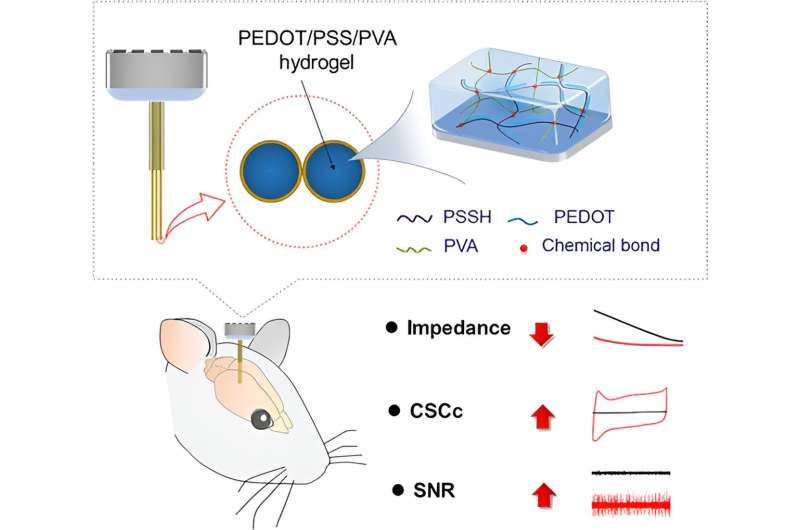This article has been reviewed according to Science X's editorial process and policies. Editors have highlighted the following attributes while ensuring the content's credibility:
fact-checked
peer-reviewed publication
trusted source
proofread
Developing novel conducting polymer-hydrogel interpenetrating networks for neural interfacing

A research group led by Prof. Lu Yi from the Shenzhen Institute of Advanced Technology (SIAT) of the Chinese Academy of Sciences (CAS) has proposed three-dimensional (3D) conductive polymer-hydrogel interpenetrating networks for high-performance chronic electrode/neural interfacing. The study was published in ACS Applied Materials & Interfaces.
Long-term, reliable detection of electrophysiological signals is pivotal for comprehending mechanisms that underlie brain disorders and for advancing effective treatments. Nonetheless, maintaining stability and biocompatibility of neural electrode interface for necessary extended periods remains challenging.
Poly (3,4-ethylenedioxythiophene), or PEDOT, is known for its excellent biocompatibility and low electrochemical impedance, making it a commonly used modified conductive polymer material in neural-electrode interfaces. However, PEDOT films often exhibit cracks or delaminations due to their limited electrochemical and mechanical stability, posing a significant challenge to the long-term viability of neural electrodes.
To address this issue, the researchers proposed a novel interface modification strategy in their work. They prepared a polystyrene sulfonate/polyvinyl alcohol (PSS/PVA) hydrogel film and applied it as a pre-coating on the surfaces of a microelectrode array, forming a 3D scaffold rich in counter ions.
Subsequently, they electropolymerized the 3, 4-ethylene dioxythiophene monomer within the PSS/PVA scaffold to create an interpenetrating conducting polymer network (ICPN). The resultant ICPN exhibited 3D highly porous microstructure, with pore sizes ranging from 0.1 to 1.0 μm.
This 3D porous structure plays a significant role in dissipating mechanical energy, enhancing adhesion, and ensuring the long-term stability of the conducting hydrogel coatings. Additionally, the ICPN film possesses a low Young's modulus (191 kPa) and remarkable stretchability (72%).
The research team also discovered that this ICPN film featured low electrochemical impedance, high capacitance, and outstanding biocompatibility, meeting the requirements for neural interfaces in a wide range of in-vivo applications.
Furthermore, the researchers conducted a comparative analysis of the electrophysiological signal quality between ICPN and PEDOT/PSS film-modified neural electrode arrays after 12 weeks of implantation into the mouse hippocampus.
Their findings indicated that ICPN-modified interfaces significantly enhanced the quality of signals during chronic electrophysiological recordings.
The study holds potential to expand applications of neural implants and provides new insights into diagnosis and treatment of neuropsychiatric disorders in the future.
More information: Mengying Yan et al, Conducting Polymer-Hydrogel Interpenetrating Networks for Improving the Electrode–Neural Interface, ACS Applied Materials & Interfaces (2023). DOI: 10.1021/acsami.3c07189
Journal information: ACS Applied Materials and Interfaces
Provided by Chinese Academy of Sciences




















